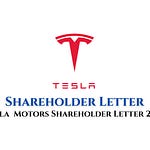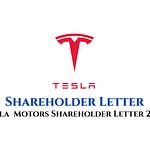Tesla 2019 Q1-Q4 Financial and Operational Briefing
Sources: Tesla Motors – First Quarter 2019 Shareholder Letter
Tesla Motors, Inc. – Second Quarter 2019 Shareholder Letter
Tesla Motors, Inc.– Third Quarter 2019 Shareholder Letter
Tesla Motors, Inc.– Fourth Quarter & Full Year 2019 Shareholder Letter
Executive Summary
Tesla's performance throughout 2019 demonstrated a significant pivot towards Model 3 production and global expansion, alongside strategic advancements in autonomous driving technology and energy solutions. While Q1 saw a dip in Model S/X deliveries and overall profitability due to seasonality and logistical challenges, the subsequent quarters showed robust recovery and growth, driven primarily by strong Model 3 performance, successful international expansion, and improved operational efficiency. Key themes include increased production and deliveries of the Model 3, strategic investments in Gigafactory Shanghai and Model Y production, continued development in Autopilot and Full Self-Driving (FSD), and a renewed focus on standardizing and simplifying the energy generation and storage business.
Key Themes and Facts
1. Vehicle Production and Deliveries: A Tale of Two Models
Model S/X Decline in Q1, Subsequent Recovery: Deliveries of Model S and Model X significantly declined in Q1 2019 to 12,100 units, down from approximately 25,000 units in prior quarters. This was attributed to "weaker Q1 demand due to seasonality, pull-forward of sales into Q4 2018 in the U.S. due to the first scheduled reduction of the federal EV tax credit in Q1 and discontinuation of our 75 kWh battery pack." Production also saw a steep drop. However, Q2, Q3, and Q4 saw a recovery and stabilization in Model S/X production and deliveries, though still below their 2018 peaks.
Model 3 as the Growth Engine: The Model 3 continued to be Tesla's primary growth driver.
Q1 2019: Model 3 deliveries were 50,928 units, a significant increase year-over-year (522% YoY) despite challenges in international logistics. Production increased 3% QoQ to 62,975 units.
Q2 2019: Model 3 production reached 72,531 units (15% QoQ increase), and deliveries hit 77,634 units (52% QoQ increase).
Q3 2019: Model 3 production continued to climb to 79,837 units (10% QoQ), with deliveries at 79,703 units (3% QoQ).
Q4 2019: Model 3 production reached a record 86,958 units (9% QoQ), and deliveries achieved a record 92,620 units (16% QoQ).
Overall 2019: Tesla reaffirmed its 2019 delivery guidance of 360,000 to 400,000 vehicles, representing a 45% to 65% increase over 2018. Q4 2019 achieved "record vehicle deliveries of 112,095 in Q4," contributing to a robust annual performance.
Inventory Management: Tesla significantly reduced its global vehicle inventory in terms of "days of sales" from 30 days in Q1 to a low of 11 days in Q4, which is "less than half of US industry average and in line with our historical numbers" (Q1 2019). By Q3, it was "the lowest level of the past 3.5 years and 4x lower than industry average."
2. Financial Performance: Volatility to Profitability
Q1 Financial Dip: Q1 2019 saw a sharp decline in automotive revenue to $3.72 billion (down 41% QoQ) and GAAP automotive gross margin to 20.2% (down 415 bp QoQ). The company reported a significant GAAP net loss of $(702) million.
Q2 Recovery: Total revenues rebounded to $6.35 billion (40% QoQ increase), and the operating loss decreased significantly. However, GAAP net loss remained substantial at $(408) million.
Q3 Return to Profitability: Tesla achieved "Profitability $261M GAAP operating income; 4.1% operating margin" and "$143M GAAP net income." Automotive gross margin improved to 22.8%. Free cash flow also turned positive at $371 million.
Q4 Strong Finish: The positive trend continued with "$359M GAAP operating income; 4.9% operating margin in Q4" and "$105M GAAP net income." Free cash flow reached $1.013 billion, marking a strong close to the year.
Cash Position: Tesla's cash and cash equivalents fluctuated, dropping in Q1 to $2.198 billion, but recovering strongly to $4.955 billion in Q2 and $6.268 billion by Q4 2019.
Outlook on Profitability: By Q4, Tesla expressed confidence in its financial trajectory: "We expect positive GAAP net income going forward, with possible temporary exceptions, particularly around the launch and ramp of new products. Continuous volume growth, capacity expansion, and cash generation remain the main focus."
3. Global Manufacturing Expansion and Capital Efficiency
Gigafactory Shanghai: This facility was a major focus, embodying Tesla's lessons learned from Model 3 ramp in Fremont. It was designed to be "at least 50% cheaper per unit of capacity than our Model 3-related lines in Fremont and at Gigafactory 1." The construction was remarkably rapid, going "10 MONTHS FROM GROUND BREAKING TO PRODUCTION READY." The Gigafactory Shanghai began local production of battery packs in late Q4 2019, with the goal of increasing Model 3 capacity further and planning Model Y production there. Gigafactory Shanghai was "almost fully funded through local debt," with a "$510 million credit line from local banks" secured by Q2.
Model Y Production: The Model Y production ramp "started in January 2020, ahead of schedule" at the Fremont factory. Tesla aims for a combined Model 3 and Model Y capacity of "500,000 units per year" at Fremont by mid-2020, with Model Y deliveries beginning by the end of Q1 2020.
Capital Expenditures: Capital expenditures remained relatively low throughout 2019, demonstrating Tesla's focus on capital efficiency, particularly with the new Gigafactory Shanghai model.
4. Technology Advancements: Autonomy and Efficiency
Full Self-Driving (FSD) and Robotaxis: Tesla held its first "Autonomy Investor Day" in Q1, showcasing its "new in-house designed full self-driving (FSD) computer" capable of processing "2,300 images per second, about 21-times more than the processor we used previously." The long-term vision includes a "custom-made robotaxi capable of running about a million miles using a single battery pack" costing "less than $38,000 to produce," aiming for the "lowest cost of ownership, and to be the most profitable autonomous taxi on the market."
Software Updates (V10): In Q3, Tesla released the "V10" software update, which "introduced streaming video (i.e., YouTube, Netflix, Hulu, video tutorials), Spotify, Caraoke (i.e., in-car karaoke), additional games, improved search and other functionalities." This highlights Tesla's continued focus on enhancing the in-car experience through over-the-air updates.
Powertrain Efficiency and Range: Tesla continued to improve the range of its vehicles through "more efficient energy use rather than a costly increase to the battery size."
Model S (370 miles EPA) and Model X (325 miles EPA) remained "the longest range EVs ever made by a wide margin" in Q1.
Model 3 Standard Range Plus EPA range increased from 240 to 250 miles in Q3.
Model Y all-wheel drive EPA range increased from 280 to 315 miles by Q4, solidifying its position as "the most energy-efficient electric SUV in the world."
5. Energy Generation and Storage Business
Strategic Shift: Tesla made "exciting changes to improve our energy business," shifting towards "standardize the product offering, simplify the customer buying experience, and focus on the markets with the strongest economics" for residential solar and energy storage. This includes direct online purchasing with a low $99 deposit.
Storage Deployment Growth: Energy storage deployment saw significant growth, particularly in Q2 (81% QoQ to 415 MWh) and Q3 (15% QoQ to 477 MWh), reaching a "record Q4 storage deployment of 530 MWh; 26% solar growth QoQ." This was supported by increased cell supply redirected from Model 3 production.
Megapack Introduction: In Q3, Tesla introduced "Tesla Megapack a 3 MWh battery pack, pre-assembled at the Gigafactory as a single unit," designed for faster deployment and lower installation costs. First deliveries were planned for Q4 2019.
Solar Challenges and Improvements: Solar retrofit deployments declined sequentially in Q2 to 29 MW, but Tesla stated it was "in the process of improving many aspects of this business to increase deployments." Solar deployments showed signs of recovery in Q3 (48% QoQ to 43 MW) and Q4 (26% QoQ to 54 MW).
Conclusion
2019 was a pivotal year for Tesla, marked by a successful ramp-up and international rollout of the Model 3, demonstrating improved manufacturing efficiency and cost control. The company also laid critical groundwork for future growth with the rapid construction of Gigafactory Shanghai and the early start of Model Y production. Continued advancements in autonomous driving and strategic adjustments in its energy business further highlight Tesla's commitment to innovation and diversification. The financial results, while experiencing a challenging Q1, showed a strong rebound, culminating in sustained GAAP profitability and positive free cash flow in the latter half of the year, positioning Tesla for continued growth into 2020.













Share this post